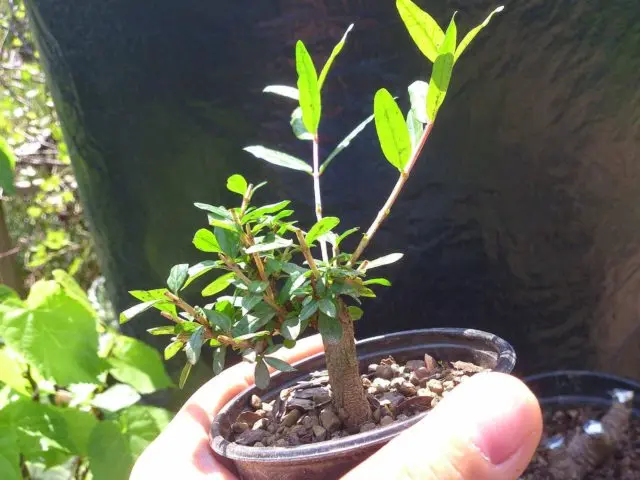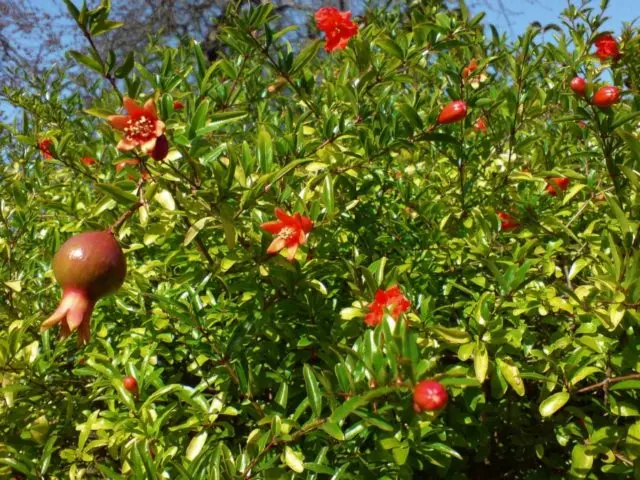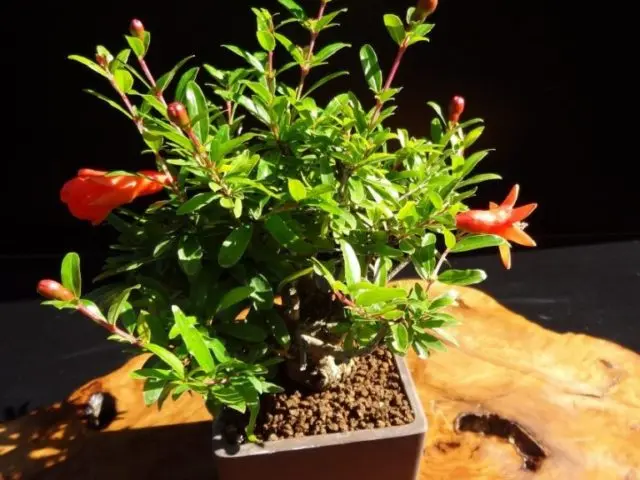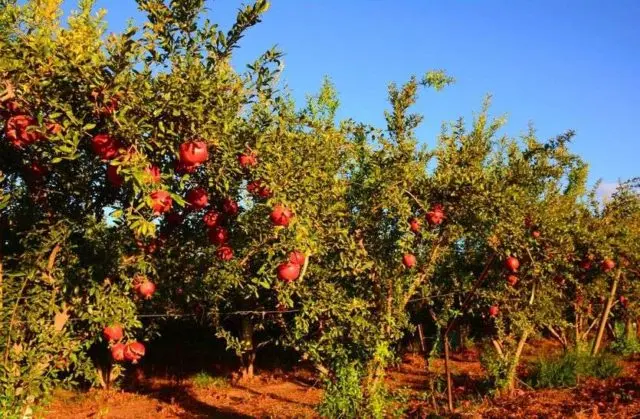Contents
Pomegranate pruning is an important step in growing a garden or houseplant. With regular competent pruning, caring for a tree becomes easier. But you need to cut the pomegranate correctly, otherwise there is a risk of damaging its growth.

Why pomegranate tree pruning is needed
Despite the fact that wild pomegranates bloom and bear fruit without formation, cultivated plants need mandatory pruning. She helps:
- to give a beautiful and geometrically correct shape to a fruit pomegranate;
- stimulate the development of lateral branches responsible for fruiting;
- strengthen the skeletal branches of the pomegranate and make it more resistant to bad weather;
- prevent excessive thickening of the crown;
- prevent the appearance of diseases and pests that more often affect pomegranates that are not pruned.
The timely formation of the pomegranate crown makes the fruit tree a noticeable element of landscape design. A well-groomed pomegranate blooms more abundantly and more beautifully, and it is possible to collect more fruits from it.
Types of pomegranate cuts
In general, pomegranate pruning can be divided into several categories – shaping, anti-aging and sanitary. At different periods of life, all of the listed types of pruning are used for pomegranate, since each of them helps to achieve different goals.
Formative
Formative pruning helps to achieve primarily the decorative appearance of the pomegranate and makes the tree easier to grow. Such pruning is carried out at the very first stages of a tree’s life – at the stage of a seedling or even a cutting.
For example, a forming pruning for a cutting would look like this:
- if the stalk grows with one stem, then at a height of 10-15 cm, the top is pinched off;
- the side branches of the pomegranate are pruned, forming no more than 6 shoots, and the pinching and pruning must be carried out at the height where the crown should begin;
- a high, even support is placed next to the pomegranate trunk, to which the plant is tied – this will prevent the main shoot from bending.
If a pomegranate from a cutting initially gives several branches at once, then you need to wait until the shoots grow a little, and remove the weakest and lowest ones. The seedling is transplanted into open ground when it reaches half a meter in height, and the formation of the trunk and crown continues for the next year.
With the help of forming pruning, you can give the pomegranate the shape of a standard tree or a sprawling bush. And at home, the plant is often turned into a decorative bonsai.
Sanitary
Sanitary pruning is important to the pomegranate as it helps keep the tree healthy. Its meaning lies in the fact that every year the pomegranate gets rid of all damaged, dry and weakened branches, as well as unnecessary shoots that thicken the crown. Thanks to sanitary pruning, the pomegranate suffers less from fungal diseases and pests, grows stronger and healthier.
Rejuvenating
Anti-aging pruning is used for adult perennial pomegranates, the growth of which has stopped, and the fruiting has worsened. Usually, during it, the crown is completely removed to stimulate the growth of young fruit shoots. Such pruning is carried out very rarely, about once every 25 years, after the pomegranate has time to practically exhaust its strength.

How to prune a pomegranate tree in the garden
Pruning garden pomegranate is mainly aimed at increasing its yield, as well as giving the tree a decorative look. In addition, pruning helps the pomegranate survive the winter more easily, since a well-groomed tree is much easier to protect from frost.
How to prune a pomegranate in spring
Most often, pomegranate fruit is cut in the spring, in early April, before the start of active vegetative processes. During pruning, you must adhere to the following rules:
- all shoots in the lower part of the pomegranate and at its roots are removed;
- dry, broken and weakened branches are cut at the root, and then burned to prevent the appearance of diseases;
- no more than 6 main shoots are left on the pomegranate bush; with a strong thickening, the plant loses its decorative effect and begins to bear fruit worse;
- the branches of the tree are processed so that the middle of the crown has access to fresh air for ventilation and is clearly visible.
All pomegranate pruning work in the spring should be done using sharp and clean garden tools. Cut sites should be treated with garden pitch or fungicidal agents. This will help the pomegranate to recover faster after formation and also prevent fungi and pests from infecting the tree.
How to prune a pomegranate in autumn
Autumn pomegranate pruning practically does not differ from spring formation. During it, in the same way, it is necessary to remove all weak, dry and broken branches, thin out the shoots in the lower part of the bush and cut off excess shoots that thicken the crown. However, some important rules apply specifically to the autumn formation.
- Pomegranate pruning in the fall is carried out only after harvesting, the plant should finish the active growing season and prepare for winter dormancy.
- However, you need to cut the pomegranate before the onset of the first frost. If by the time of pruning the tree has already retired, the procedure can damage the health of the pomegranate or disrupt its wintering.
How to form a room pomegranate
Fruit lovers often grow miniature pomegranates from the stone in pots. Pruning is necessary for indoor pomegranate in the same way as for garden pomegranate, it is responsible for the beautiful shape of the crown and also helps to strengthen the health of the plant.
Pomegranate pruning at home is carried out as follows:
- after the tree grows a little, pinch it at a height of about 12 cm – this stimulates the growth of lateral shoots and allows you to form a sprawling bush from a pomegranate;
- if you want to give the plant the shape of a small tree, then you need to pinch the main shoot a little higher, at a level of 20 cm or in the place where you need to get the crown of the plant;
- in the process of growth of young branches, they continue to pinch and cut until the crown of the desired shape is formed.

After the formation of a pomegranate at home bears fruit, all that remains is to monitor the growth of the shoots and not allow them to violate the initially set outlines.
Indoor pomegranates that have not been pruned, in principle, cannot acquire a decorative shape, they grow with only one stem vertically upwards and look inconspicuous. And the flowering and fruiting of the plant comes very late, even if all other growing rules are observed.
Formation of pomegranate bonsai
When forming a potted pomegranate, you can turn a house plant into a bonsai – a miniature and highly decorative artistic tree that will serve as a striking design element.
To create a bonsai, grown plants with a thickness of the main trunk of at least 2,5-3 cm are suitable. The formation procedure looks like this:
- all unnecessary branches and shoots of the plant are removed;
- the main trunk is cut at the desired height – usually about 20-25 cm;
- the trunk is carefully bent, making sure that it does not break, and fixed with a stiff wire so as not to allow it to straighten back;
- the remaining branches are also bent at will at the desired angle and fixed with a fishing line;
- as the shoots grow, they are pruned so as not to disturb the outlines of the formed crown;
- the crown of the pomegranate bonsai is left sufficiently thinned out, otherwise mold may appear in the thickened branches.
Caring for a homemade bonsai pomegranate is carried out in the same way as for an ordinary tree, it must be watered, fed and transferred to new containers as it grows. The main attention should be paid to maintenance pruning, because without it, the tree can quickly thicken the crown and lose its decorative appearance.
The branches and shoots of the plant are very flexible, so in the photo of the care and pruning of a homemade pomegranate, you can see that with due effort, a miniature tree easily takes on the desired shape. At the same time, pruning and shaping in the bonsai style does not affect the health of the home tree, the pomegranate continues to grow and develop, although it needs more careful observation and care.
Tips from experienced gardeners
In addition to the basic rules for growing and pruning pomegranate, there are important nuances that experienced gardeners know about. When caring for a pomegranate tree, you need to know some secrets of successful formation.
- Pomegranate branches bear fruit no more than 4 years in a row. After that, you can safely carry out pruning, since they will no longer participate in the harvest.
- After pruning a young or adult plant, the cut points must be treated with garden antiseptics and fungicides. It is important to prevent infection of the cuts, otherwise, after pruning, the pomegranate can get fungal diseases or attract insect pests.
- After about 25 years of life, the pomegranate practically ceases to bear fruit. During this period, it is recommended to carry out cardinal pruning of the crown to the very root. It will not harm the tree. Soon, new shoots will appear on the trunk, of which 4-5 strongest shoots will need to be left for further development.

Although the pomegranate in the standard form looks very attractive, in the northern regions of the country, experienced gardeners recommend pruning so that the pomegranate acquires a bush shape. Pomegranate belongs to heat-loving plants, and a sprawling bush is much more convenient to cover and insulate with the onset of cold weather than a tall standard tree.
Conclusion
Pomegranate pruning is a procedure that must be carried out when caring for a garden or indoor fruit plant. Sanitary pruning keeps the pomegranate healthy, while shaping and maintenance clippings help keep the pomegranate’s attractive shape and increase annual yields.









